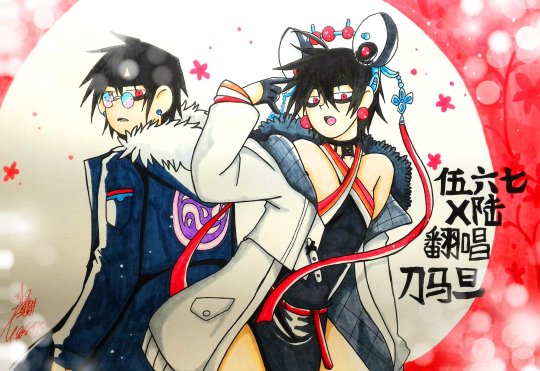#daomadan
Explore tagged Tumblr posts
Photo




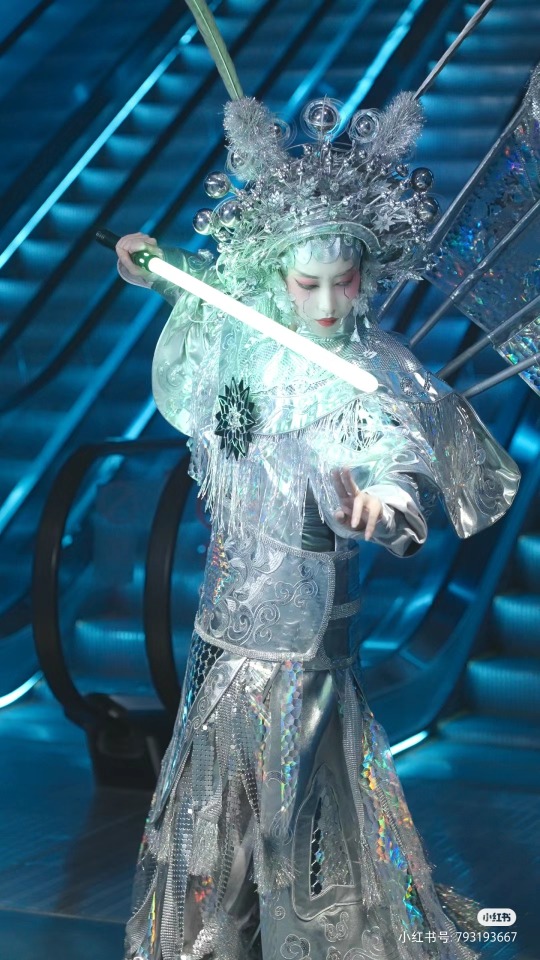
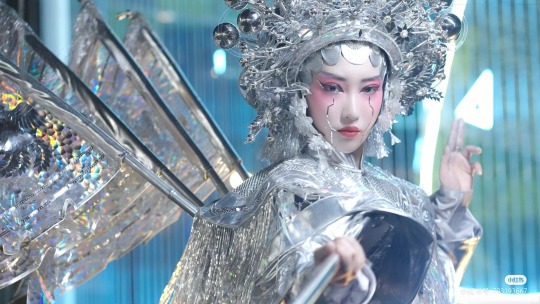
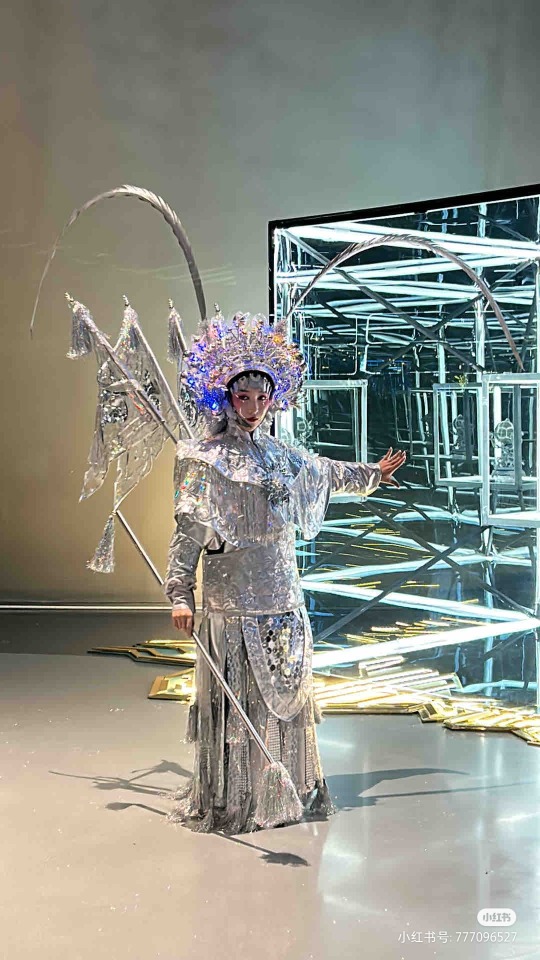
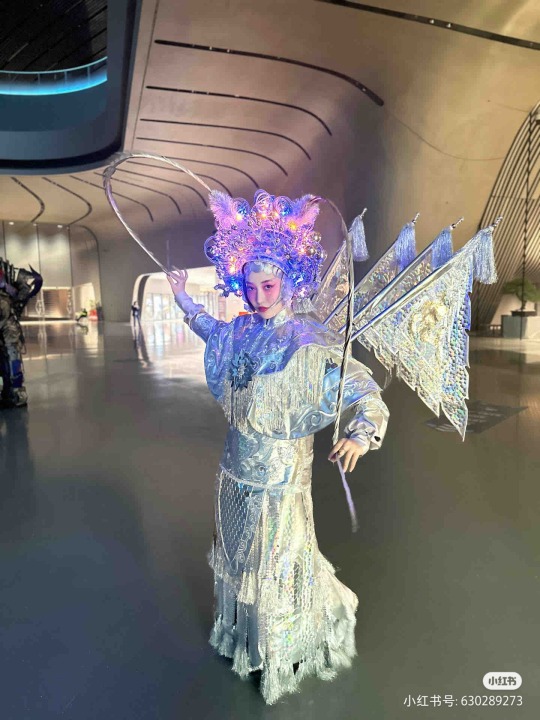
cyberpunk daomadan刀马旦 of chuanju川剧 (sichuan opera) at World Science Fiction Convention 2023 by 雁鸿Aimee
#china#fun#WSFC#world science fiction convention#photography#cyberpunk#op named her work as 川剧机械梦幻少女#daomadan#chuanju
4K notes
·
View notes
Text
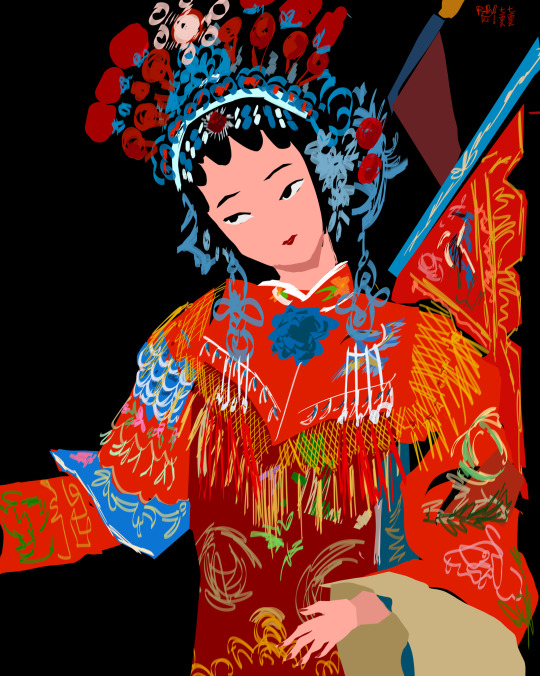
刀馬旦
daomadan
3 notes
·
View notes
Text
April 20, Beijing, China, National Museum of China/中国国家博物馆 (Part 2 - Dehua white porcelain exhibition/德化白瓷展 continued):
This was actually the very first piece I encountered at the entrance to the exhibition, a gigantic basket of flowers (probably over 1 meter tall and over 1 meter wide?), the entire thing made of porcelain.
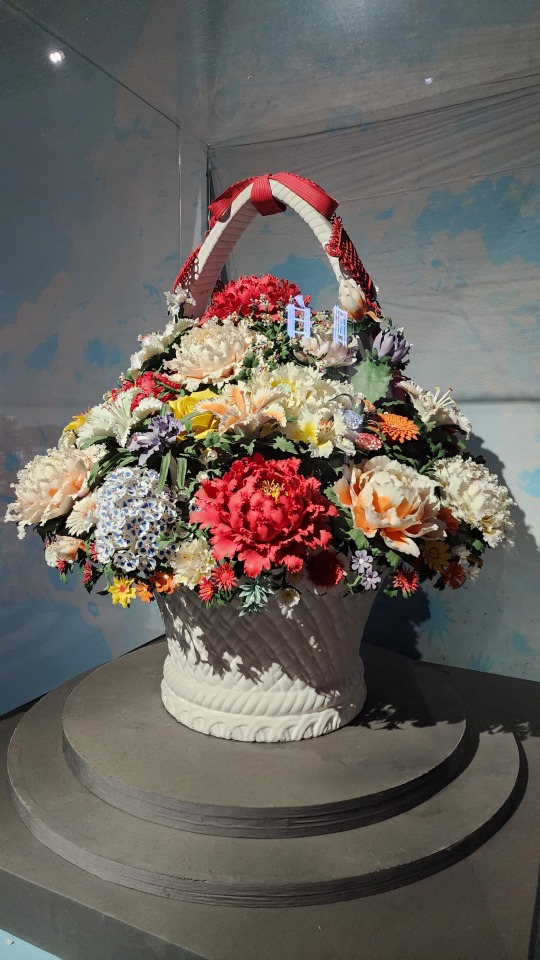
And to reiterate, every part of every piece is porcelain. Though I will say that despite the ultra-realistic shape of the flower petals and leaves, the only detail that hinted at these flowers being made out of porcelain was that the painted colors weren't as vibrant as real flowers. That's it. If you don't examine it up close you really can't tell that it's all porcelain.

This is a good place to roughly introduce the technical side of Dehua white porcelain. The color of Dehua white porcelain mainly comes from the clay it uses, which is a special kaolin clay (gaolingtu/高岭土 in Chinese) found in Dehua. The clay mineral used naturally contains sericite and quartz, both of which are silica minerals and may have contibuted to the almost translucent look of the finished pieces; it also contains comparatively high amounts of potassium oxides, while the amount of iron oxides present is low. Due to the intricate designs of the pieces, the firing success rate may be very low. All those pieces involving super thin parts representing fabric or paper or flower petals? They may bring the success rate down to about 5%. Which means many of these pieces may be the 15th-20th try that finally survived firing. For people who are more interested in the chemistry of Dehua white porcelain, this paper goes into depth about it. There's also a great book in Chinese that goes into depth all about Dehua porcelain. (link goes to the first chapter only)
Continuing on, this is one of many Guanyin/观音 (Avalokiteśvara) statues at the exhibition, again with light clothing made out of porcelain:
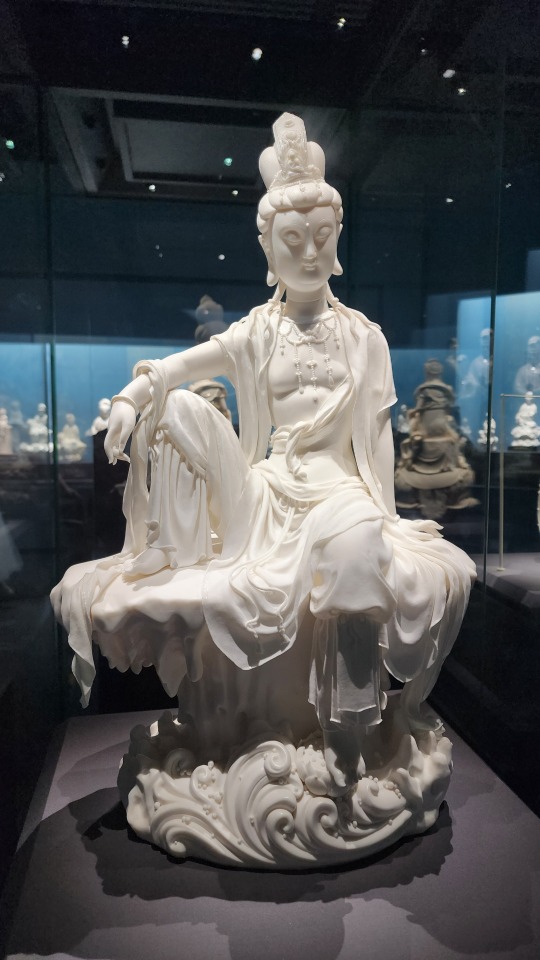
More Guanyin statues in various classic depictions/forms, of which there are 33 total. This particular form is called Yulan Guanyin/鱼篮观音 (鱼篮 means fish basket), and comes from a legend where Guanyin transformed into a beautiful female fish vendor in order to guide mortals.
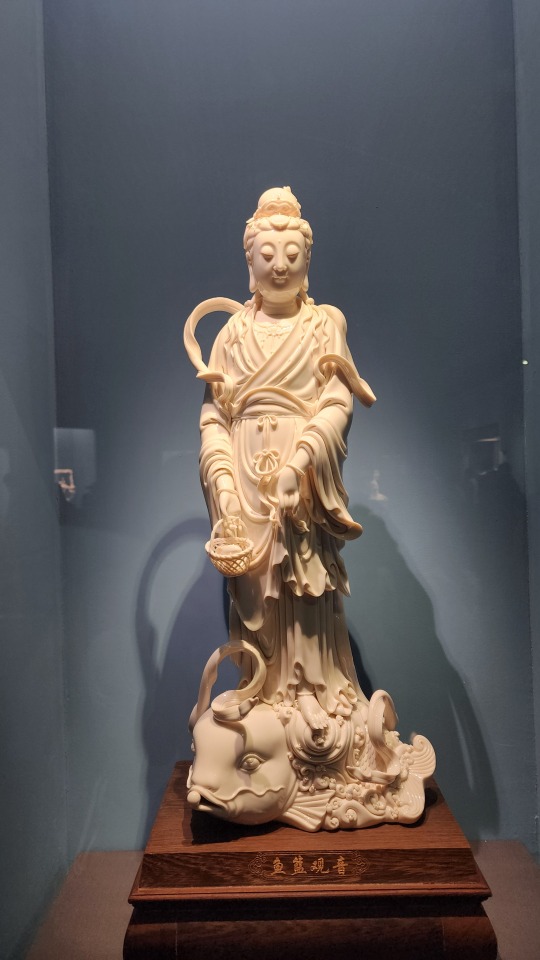
I believe the text here reads 持经观音 (Guanyin holding scripture)? The Guanyin here is holding a vase instead of a scroll though.
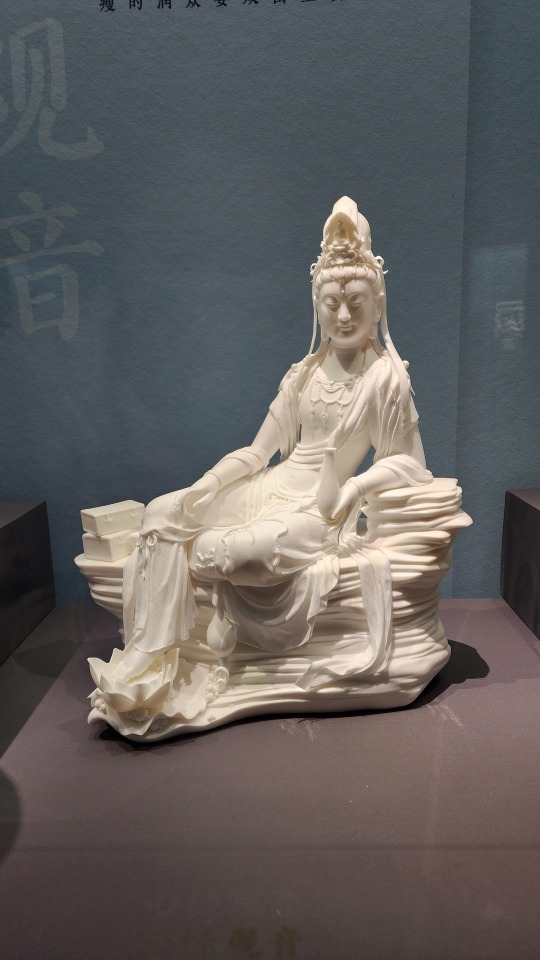
This is a classic depiction of Guanyin with a little bit of a modern-ish twist? Guanyin is often depicted with a vase of divine water, but here it forms a circle.
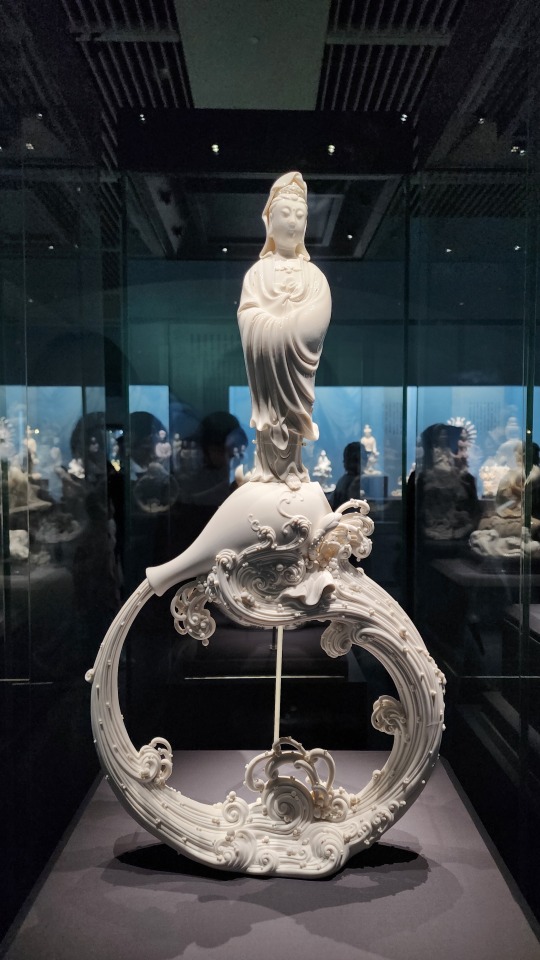
Despite some of the Guanyin statues having the amazing ceramic "clothing", this one remains my favorite, just because of the sense of space and serenity that this simple "frame" design creates:
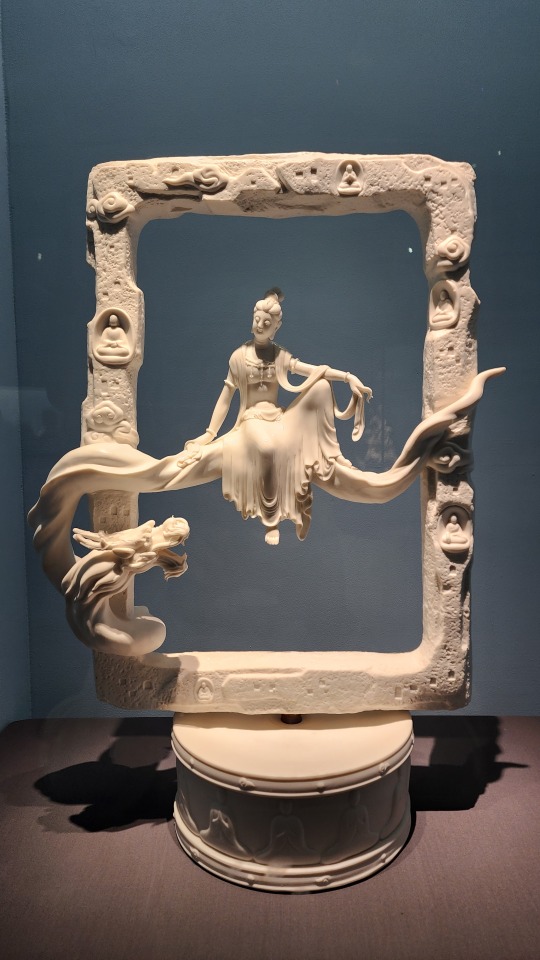
And this very literal take on "thousand arm Guanyin" (千手观音). It's giving me that "biblically accurate angels" vibe:
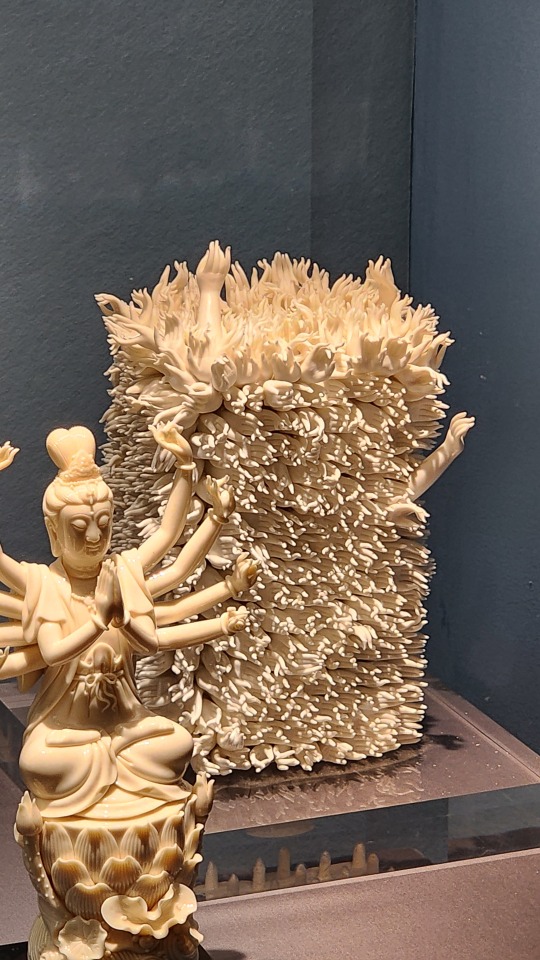
Buddha floating atop.......idk what that is but the texture is amazing:

A fully painted statue of Guanyu/关羽. The gradient and detailed patterns on his robes is amazing:
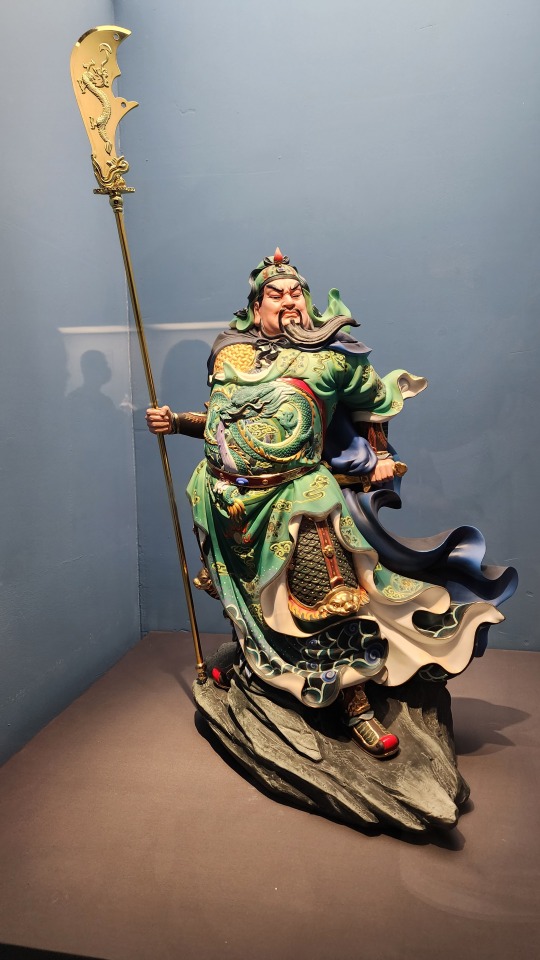
Two identical (I think?) statues of the daomadan/刀马旦 (female commander archetype) character Mu Guiying/穆桂英 as she would appear in Chinese traditional opera, one painted and one unpainted. The word 巾帼英雄 in the title means "hero in women's headscarf", which is a term used exclusively in reference to female heroes. There's also the phrase "巾帼不让须眉", which roughly means "those in women's headscarves aren't inferior to those with beards and thick brows"

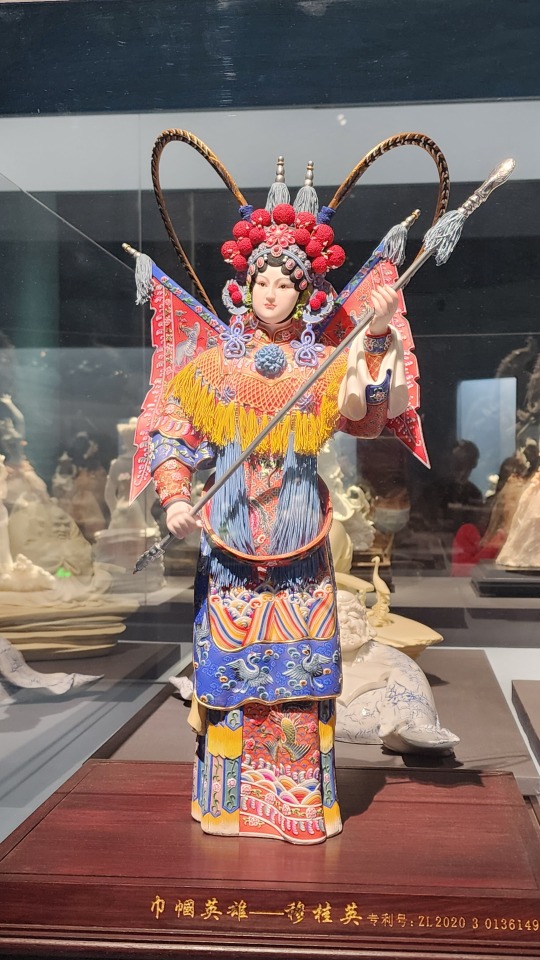
Porcelain depiction of Dunhuang's famous feitian/飞天 figures, in the classic pose of playing pipa in reverse (called 反弹琵琶). The clothing on this figure is made of porcelain, but this time also painted:
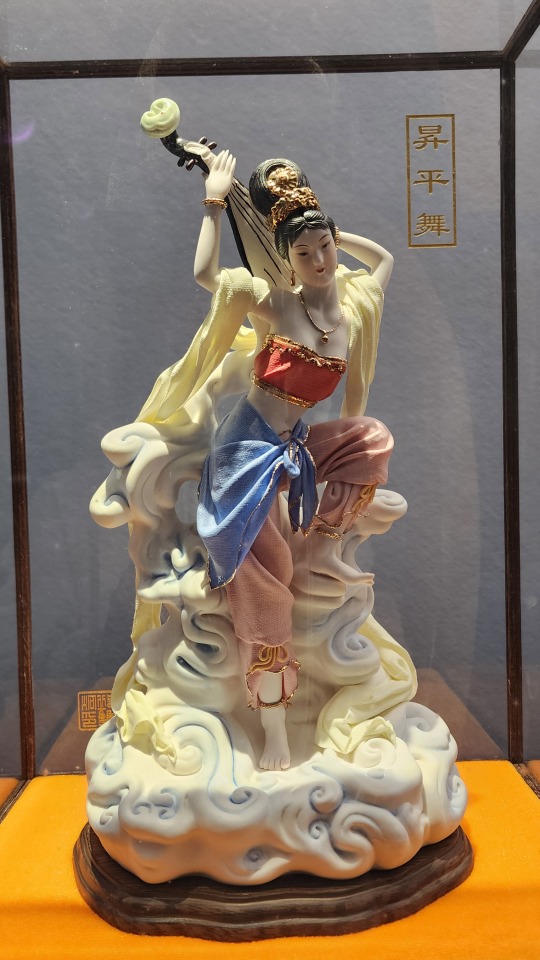
A porcelain statue of a couple in traditional Lhoba/Luoba/珞巴 clothing. The Lhoba/Luoba people are one of China's 55 少数民族 who mainly live in the south-eastern region of Tibet Autonomous Region, and as of 2019, it is the 少数民族 with the smallest population
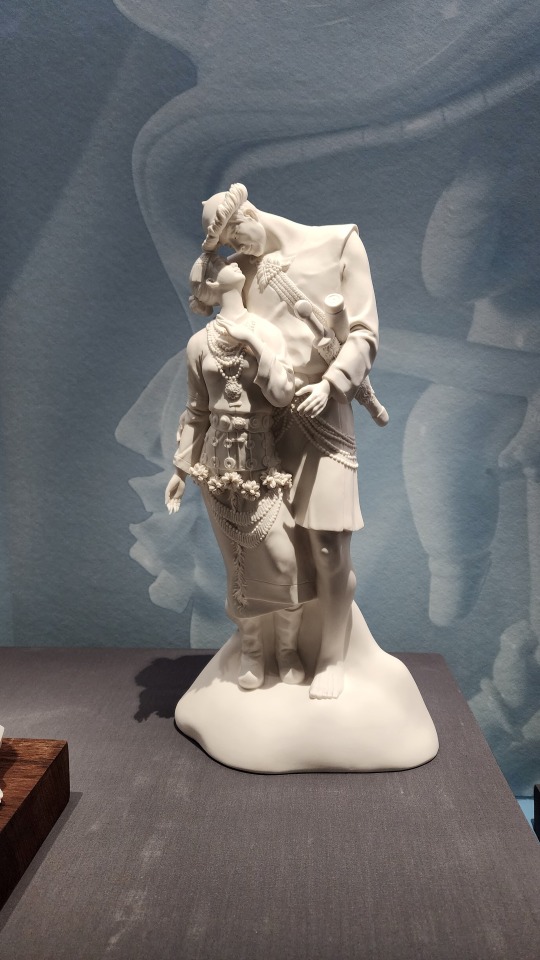
A porcelain statue of a woman in traditional Miao/苗 clothing. I love how the artist recreated the traditional Miao silver crown in porcelain.
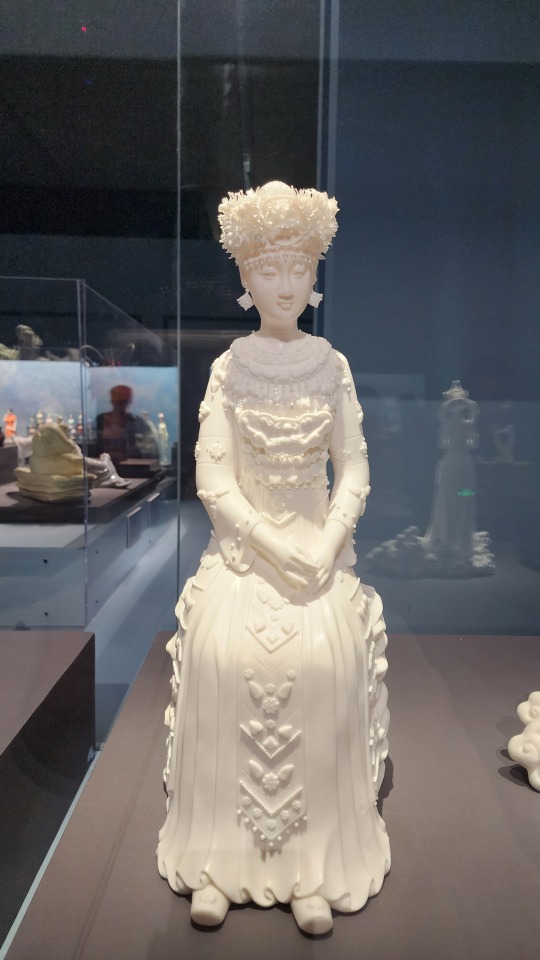
Painted porcelain bust of a woman wearing the Xunbu/蟳埔 "flower crown", named a zanhuawei/簪花围. The town of Xunbu in Fujian province is known for its tradition of zanhua/簪花, or wearing flowers in one’s hair.
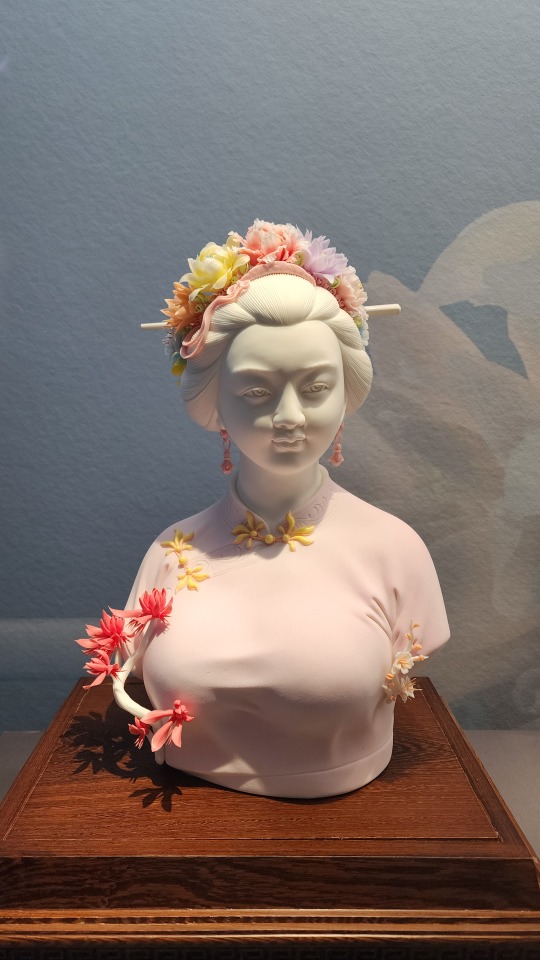
Porcelain statue of a Buddhist monk wearing a zhiduo/直裰 (the robes on the inside) and a jiasha/袈裟 (काषाय/kasaya; the garment on the outside that drapes over the left shoulder). From its looks, one can tell that zhiduo originated from hanfu, but with some minor changes (sidenote, this is not the same as the zhiduo of Ming-era hanfu). Jiasha evolved from the clothing of Indian Buddhist monks, but there appears to be a lot of influence from Central Asia and ancient Greece as well (link goes to pdf; this article is in Chinese).

Some modern-themed pieces. Look at those dresses omg
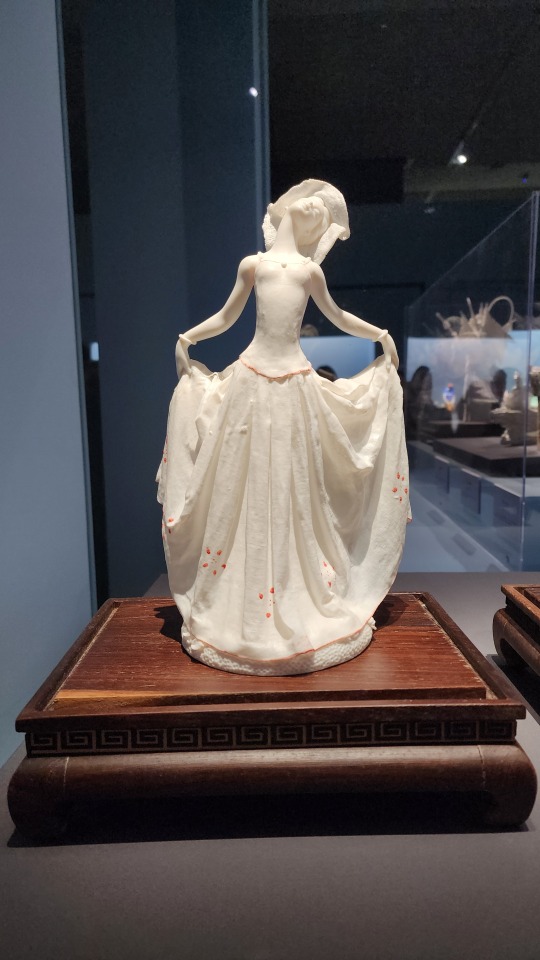
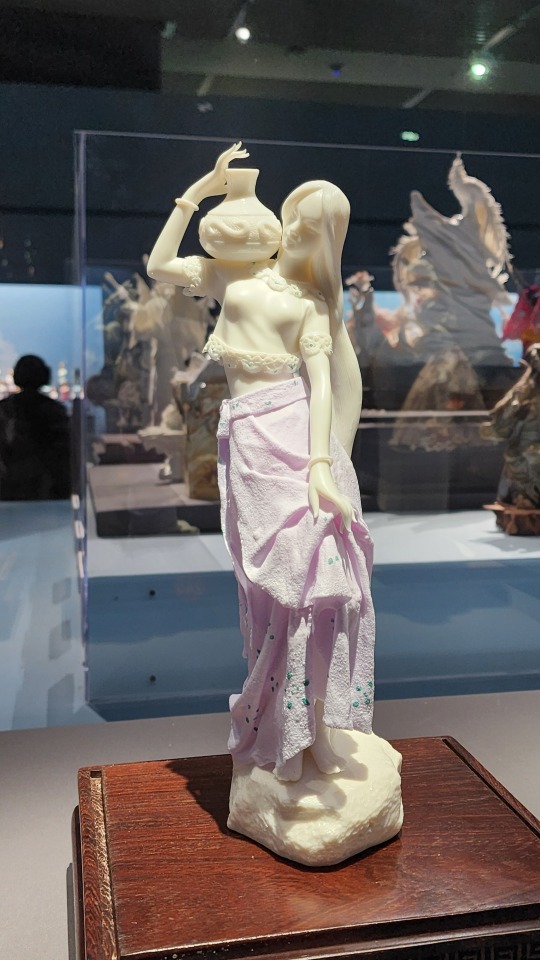
A porcelain statue of Hua Mulan/花木兰, the character from traditional Chinese literature and opera that inspired the Disney character. I will say though this pose reminds me of someone else.......

#2024 china#beijing#china#national museum of china#dehua porcelain#blanc de chine#porcelain#chinese art#chinese culture#art#culture#buddhism#guanyin
573 notes
·
View notes
Text

behind the scenes!

keep reading for details about the drawing!!
on the upper left corner is a ticket to xinyan's concert plus a signed picture, the person with the newspaper is yunning (yun jin's manager) the newspaper has a picture of yun jin, on the upper right corner there's a note from shenhe that says 慢慢吃 or eat slowly/eat well. i also put a polaroid of shenjin <3
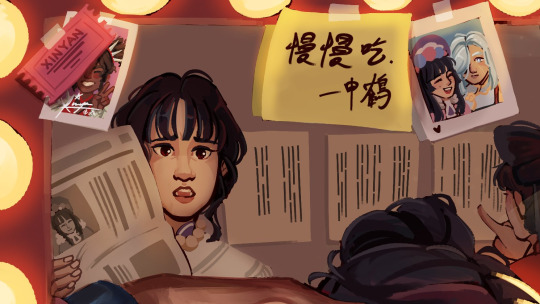
in the background there are some yun han opera troupe members!! one dan and one sheng.
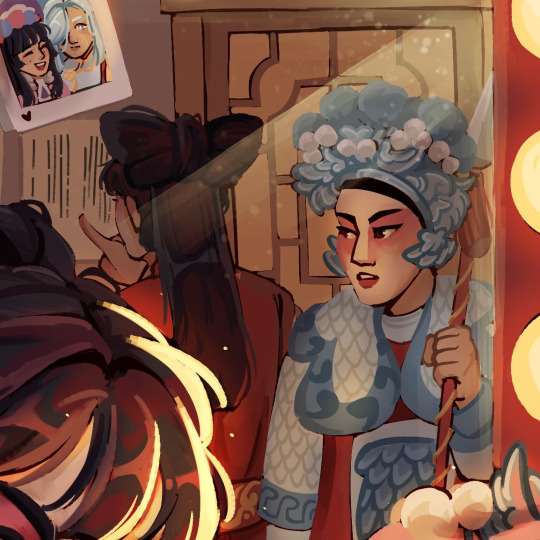
on the table, you can see the sideburns opera artists use for their costumes, the makeup yun jin is using and tianshu meat which is one of yun jin's favorite dishes. and as shenhe's note implies, she's the one who delivered the food to yun jin <3
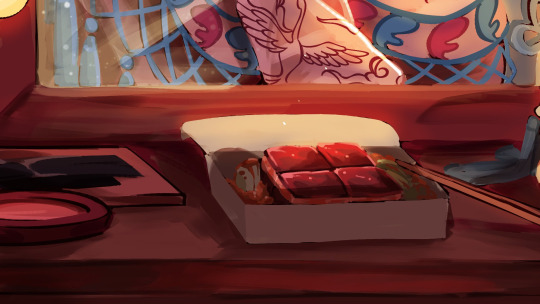
finally, yun jin is putting on make up and i drew her as a daomadan in a pink costume which im pretty sure signifies that her character is a young warrior!!

#genshin impact#yun jin#shenhe#xinyan#shenjin#fanart#my art#original art#digital art#i was so locked in with this drawing omg#i cant remember how many days it took to finish but ik its a lot HJKASDHFASDF#my love letter to yun jin and chinese opera :D#check out my yun jin design thread on twitter if you havent!!
107 notes
·
View notes
Text
Friendssss. I procrastinated on my previous crk oc and decided to start on a new one because I saw a pretty Chinese opera lady on a crate of oranges 😋

Here he at bro
Rant about him down here …
OMG MY DREAMS OF A OPERA THEMED OC CAME TRUUUUUUU
anyways
Urhhh
I don’t know where to start…
I’m gonna start with his role in Chinese opera. Basically all you gotta know is that there are four main roles, Sheng (man), Dan (women), Jing (rough man) and Chou (clowns. Me) So basically Red Bean Paste Cookie is a Dan, more specifically a DaoMaDan which is basically put, warrior women. But, but why a he? So like basically from what I was told, back in ye olden days males are only allowed to do Chinese Opera. So therefore a male would play females roles too. But only the highly experienced men are capable of taking on the female roles. Gotta have that high pitched voice guys.
Now I’ve been thinking, do I name him Red Bean Paste or Red Bean Bun Cookie cuz you see there’s like a bun in the middle of his head gear and I like huhhhhh. Cuz it’s a RED BEAN bun, but it’s a BUN none the less…. I mean the bun came up twice.
4 notes
·
View notes
Text

Daomadan Lin Fei
140=>100
2 notes
·
View notes
Photo

They make a #homely setting out of a #dayspa #amazing #DaoMaDan #DMD #LifeInSuzhou #SuzhouLifestyle #weeklysparegime #andtherestidontcare . . . #CNIG #IGCN #wow #HappeningCN #Instadaily #instagood #like4like #photooftheday #igers #picoftheday #instamood #follow4follow #love #me #followme #beautiful #happy #cute (at Suzhou North Railway Station)
#dmd#cnig#happy#instamood#andtherestidontcare#followme#photooftheday#daomadan#dayspa#instagood#follow4follow#instadaily#igers#love#lifeinsuzhou#like4like#wow#picoftheday#amazing#happeningcn#weeklysparegime#cute#suzhoulifestyle#me#beautiful#homely#igcn
0 notes
Photo

Chinese Opera - Identity Map
Traditional Chinese Opera is a drama performance and musical theater in which includes many elements: music, dance, acting, and martial arts. It combined music, art and literature into one performance on the stage.
To have a Chinese Opera, there must be a Host who hires a Chinese Opera troupe. The members of the troupe are the owner, stylist, actors and musicians. Each members can switch roles and each members can play more than one roles.
Roles:
Sheng — Male Role
Laosheng - polished manners of the middle-aged mandarin official or scholar
Hongsheng - had a red face, a sub-category of Laosheng
Xiaosheng - handsome young male with no beard
Wusheng - good at martial arts roles
Dan — Female Roles
Zhengdan (Qingyi) - the main woman roles
Guimendan - an unmarried and young girl
Daomadan - a female warrior role
Huadan - the vivacious and unmarried woman role
Laodan - an old and clever woman
Wudan - a female acrobatic role
Jing - Painted Face Male Role
Tongchui - good at singing and usually a loyal general
Jiazi - good at acting with less emphasis on singing
Wujing - a martial arts and acrobatics role
Chou - the Comedy Role
Wenchou - a civilian role such as a merchant or jailer
Wuchou - a military role, skilled in acrobatics
Make up and costume:
The colors of the costume defines the role of the character. For instance, since green defines as violence, the antagonist character would wear green. The pattern on the costumes also have meaning. The pattern are usually flowers and dragons.
The actors always wear heavy makeup. White makeup defines as smooth, pale skin. Pink defines as healthy (when blood circulates well). Black defines as hair on the body.
Stage:
The stage that are usually use is a makeshift stage. The front part is for the performance, two sides are for musician, and back part is for preparation.
Performance:
Chinese Opera in Thailand is mostly Teochew Opera, which was brought to Thailand when Teochew people immigrated to Thailand. Chinese Opera occurs during festival/events:
Chinese New Year
Moon Festival
Vegetarian Festival
god’s birthday
Places:
The performance can be mostly found in the shrine. If there are big events, the can be found in big mall.
1 note
·
View note
Photo
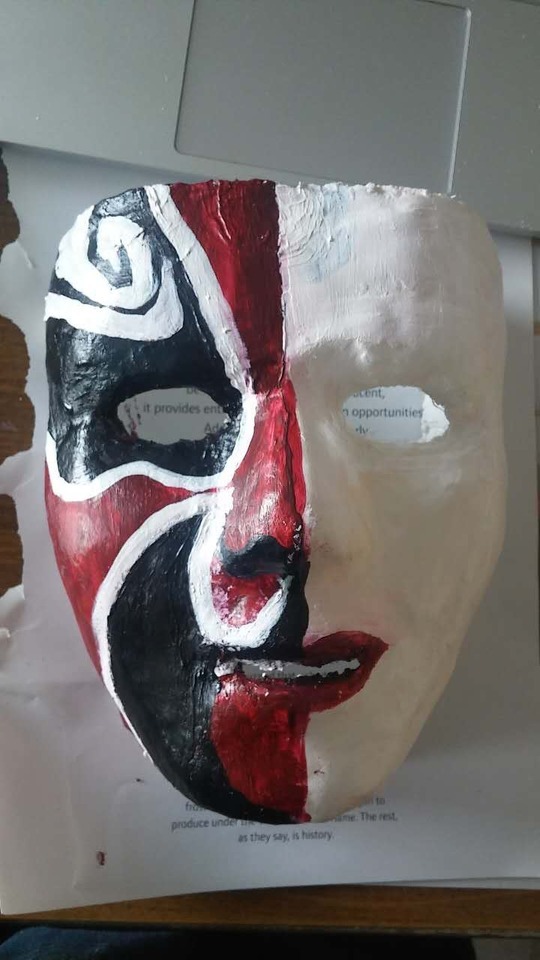

I started to paint on it, the best media to paint on it is acrylic. However, I do find the challenge of using the acrylic painting. The acrylic is too thick, so when I was using the brushes, the colour that paint on it is not smooth. Then I started to think about how to decorate the right part of the mask.
I want to explain the Chinese side of the mask a little bit.
Peking opera or Beijing opera (Chinese: 京剧; pinyin: Jīngjù) is a form of Chinese opera which combines music, vocal performance, mime, dance, and acrobatics. It arose in the late 18th century and became fully developed and recognized by the mid-19th century.[1] The form was extremely popular in the Qing dynasty court and has come to be regarded as one of the cultural treasures of China.[2] Major performance troupes are based in Beijing and Tianjin in the north, and Shanghai in the south.[3] The art form is also preserved in Taiwan (Republic of China), where it is known as Guójù (traditional Chinese: 國劇; simplified Chinese: 国剧; literally: "National theatre"). It has also spread to other countries such as the United States and Japan.[4]
The roles on the Peking Opera stage fall into four major roles-Sheng (生), Dan (旦), Jing (净), Chou (丑).[43]
Sheng (生): refer to men, divided into Laosheng (老生),Xiaosheng (小生),Wusheng (武生)
Dan (旦): refer to women, divided into Zhengdan (正旦), Laodan (老旦), Huadan (花旦), Wudan (武旦), Daomadan (刀马旦)
Jing (净): refer to painted-face role, know popularly as Hualian, divided into Zhengjing (正净), Fujing (副净), Wujing (武净), Maojing (毛净)
Chou (丑): refer to painted-face role, know popularly as Xiao hualian, divided into Wenchou (文丑), Wuchou (武丑), Nüchou (女丑)
The Sheng (生) is the main male role in Peking opera. This role has numerous subtypes. The laosheng is a dignified older role. These characters have a gentle and cultivated disposition and wear sensible costumes. One type of laosheng role is the hongsheng, a red-faced older male. The only two hongsheng roles are Guan Gong, the Chinese god of sworn brotherhood, loyalty and righteousness, and Zhao Kuang-yin, the first Song Dynasty emperor. Young male characters are known as xiaosheng. These characters sing in a high, shrill voice with occasional breaks to represent the voice changing period of adolescence. Depending on the character's rank in society, the costume of the xiaosheng may be either elaborate or simple.[50] On-stage, xiaosheng actors are often involved with beautiful women by virtue of the handsome and young image they project.[51] The wusheng is a martial character for roles involving combat. They are highly trained in acrobatics, and have a natural voice when singing.[50] Troupes will always have a laosheng actor. A xiaosheng actor may also be added to play roles fitting to his age. In addition to these main Sheng, the troupe will also have a secondary laosheng.[52]
The Dan (旦) refers to any female role in Peking opera. Dan roles were originally divided into five subtypes. Old women were played by laodan, martial women were wudan, young female warriors were daomadan, virtuous and elite women were qingyi, and vivacious and unmarried women were huadan. One of Mei Lanfang's most important contributions to Peking opera was in pioneering a sixth type of role, the huashan. This role type combines the status of the qingyi with the sensuality of the huadan.[53] A troupe will have a young Dan to play main roles, as well as an older Dan for secondary parts.[48] Four examples of famous Dans are Mei Lanfang, Cheng Yanqiu, Shang Xiaoyun, and Xun Huisheng.[54] In the early years of Peking opera, all Dan roles were played by men. Wei Changsheng, a male Dan performer in the Qing court, developed the cai qiao, or "false foot" technique, to simulate the bound feet of women and the characteristic gait that resulted from the practice. The ban on female performers also led to a controversial form of brothel, known as the xianggong tangzi, in which men paid to have sex with young boys dressed as females. Ironically, the performing skills taught to the youths employed in these brothels led many of them to become professional Dan later in life.[55]
The Jing (净) is a painted face male role. Depending on the repertoire of the particular troupe, he will play either primary or secondary roles.[48] This type of role will entail a forceful character, so a Jing must have a strong voice and be able to exaggerate gestures.[56] Peking opera boasts 15 basic facial patterns, but there are over 1000 specific variations. Each design is unique to a specific character. The patterns and coloring are thought to be derived from traditional Chinese color symbolism and divination on the lines of a person's face, which is said to reveal personality. Easily recognizable examples of coloring include red, which denotes uprightness and loyalty, white, which represents evil or crafty characters, and black, which is given to characters of soundness and integrity.[57] Three main types of Jing roles are often seen. These include tongchui, roles that heavily involve singing, jiazi, roles with less emphasis on singing and more on physical performance, and wujing, martial and acrobatic roles.[50]
The Chou (丑) is a male clown role. The Chou usually plays secondary roles in a troupe.[48] Indeed, most studies of Peking opera classify the Chou as a minor role. Chou roles can be divided into Wen Chou, civilian roles such as merchants and jailers, and Wu Chou, minor military roles. The Wu Chou is one of the most demanding in Peking opera, because of its combination of comic acting, acrobatics, and a strong voice. Chou characters are generally amusing and likable, if a bit foolish. Their costumes range from simple for characters of lower status to elaborate, perhaps overly so, for high status characters. Chou characters wear special face paint, called xiaohualian, that differs from that of Jing characters. The defining characteristic of this type of face paint is a small patch of white chalk around the nose. This can represent either a mean and secretive nature or a quick wit. Originally, there were five roles in Beijing Opera, but the last role "Mo" became a part of "Chou".[50]
https://en.wikipedia.org/wiki/Peking_opera#Performers_and_roles
0 notes
Video
I’ve been meaning to reblog this for ages. I’ve yet to discuss this in depth but I am deeply invested in the various forms of Chinese Opera. A daomadan (刀马旦) is a military female role pictured below


complete with the four penant flags, pheasant feathers, and what appears to be a “belt” in the middle section of both the front and rear panel of the costume. Various martial arts stunts are performed in this costume while also accompanying the typical responsibilities of singing. Often when people picture Beijing Opera it is the Daomadan and Wusheng (male equivalent of the role) that come to mind.
dao ma dan刀马旦 from beijing opera by 甄妮刀马旦
12K notes
·
View notes
Photo

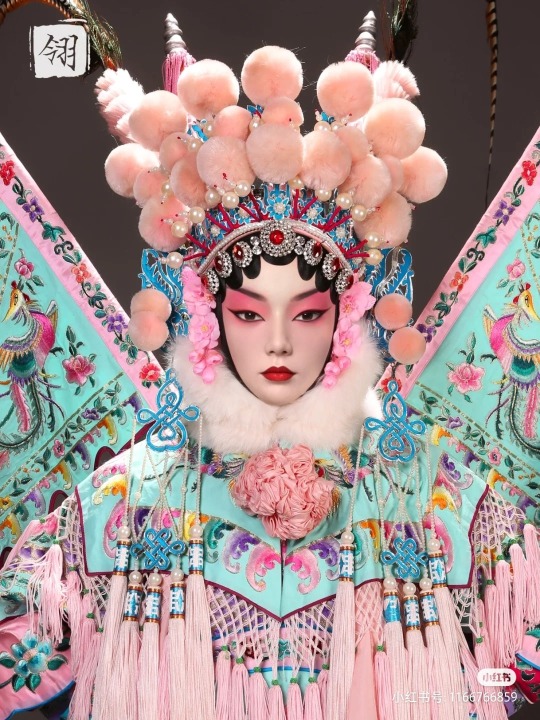
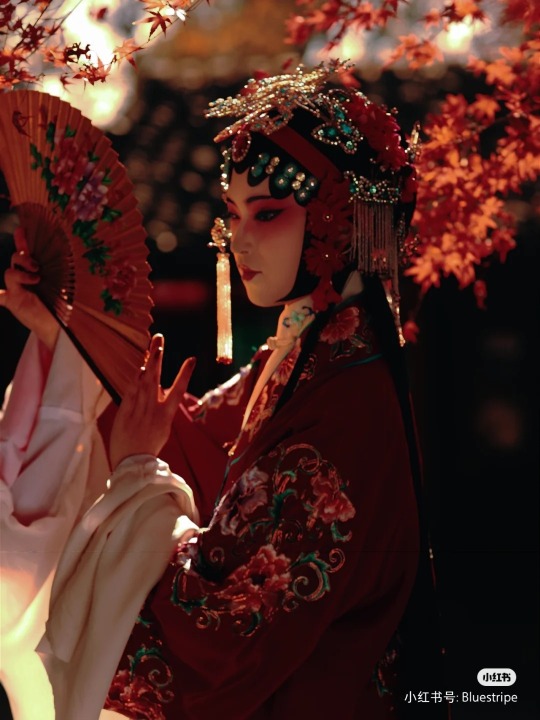

chinese opera
552 notes
·
View notes
Text
About Yunjin’s Design
Yunjin is based on the daomadan (刀马旦) character archetype in Beijing Opera. Dan (旦) means female role, and daoma (刀马) means “saber and horse”, referring to the type of action that’s characteristic of this role. Altogether daomadan is a female role that fights on horseback in the course of the story. This type of female character is often a heroic warrior, and sometimes even a general leading troops in battle. If the female role does not fight on horseback, then it’s generally referred to as wudan (武旦), or “martial female role”. Daomadan can be understood as a subtype of wudan.
This is supported by both what Yunjin did in her character demo and one of her idle animations, where she twirls and kicks a baton-like object. In Beijing Opera, this “baton” is understood to represent a spear or a spear-like polearm weapon, and the acrobatics represent the moves when fighting. Here is a video excerpt example from an old opera named Oulianguan (《藕连关》). The daomadan character enters the stage at 0:42 and is seen fighting multiple male warrior characters in a battle, then rejoicing in victory.
On Yunjin’s visual design, although it’s overall more lolita than traditional, it does still contain a few design elements from Beijing Opera:
The shawl-like clothing around her shoulders is a reference to yunjian (云肩; lit. “shoulder cloud”) worn by certain dan characters in Beijing Opera, usually noble, royal, wealthy, or significant female characters.
The pom-pom-like things in her hat refers to parts of the daomadan headwear qixingezi (七星额子; lit. “seven stars headwear”), meant to represent decorations on a helmet.
The flags seen on her back during her elemental skill is a direct reference to the kaoqi (靠旗, or “armor flags”) worn by major characters who are generals or warriors fighting on the battlefield. This applies to both male and female roles. Characters who are generals but do not appear in battle (ex: Guanyu) may not have kaoqi in their costumes.
Here’s a diagram illustrating the parts of a typical daomadan costume, with the relevant parts translated:
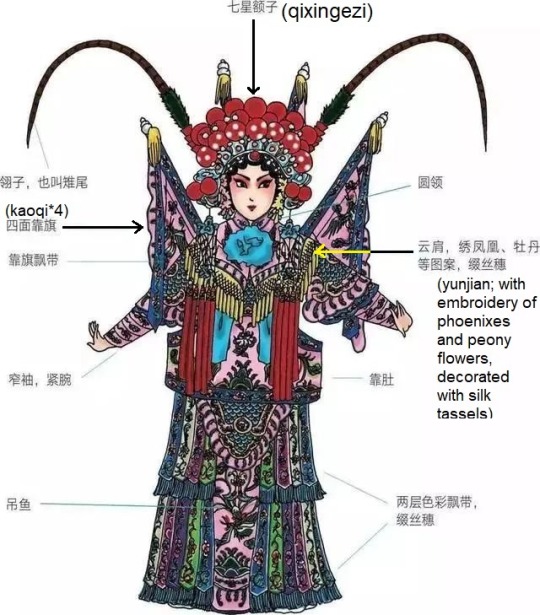
And here’s a typical daomadan costume in real life, specifically the costume for Mu Guiying in the opera “Mu Guiying Takes Command” (《穆桂英挂帅》).

268 notes
·
View notes
Text
Ok I saw Yunjin. Tbh not a huge fan of her design lol, but I don’t dislike it either, it’s just kinda meh compared to designs of other characters we have seen so far. Whoever designed her could have modified the stereotypical Lolita dress a bit more in terms of shape and form to give her just a little more of that Beijing Opera daomadan feel, but oh well.
2 notes
·
View notes
Video
SO COOL
dao ma dan刀马旦 from beijing opera by 甄妮刀马旦
12K notes
·
View notes
Video
tumblr
dao ma dan刀马旦 from beijing opera by 甄妮刀马旦
12K notes
·
View notes
